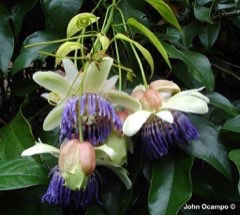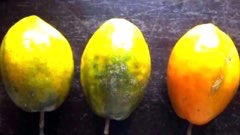 |
|
John Ocampo wikimedia.org |
 |
|
Translate this page:
Summary
Granadilla de Quijos, Passiflora popenovii, is an evergreen climbing shrub found in Colombia, Ecuador, and South America. It is known to be one of the best in the genus in terms of the flavor of the fruits. Often sold in local markets, the fruits can be eaten raw or made into drinks. The plant can be grown from seed or by cuttings, layering, and air-layering.
Physical Characteristics

 Passiflora popenovii is an evergreen Climber growing to 8 m (26ft) by 0.5 m (1ft 8in) at a fast rate.
Passiflora popenovii is an evergreen Climber growing to 8 m (26ft) by 0.5 m (1ft 8in) at a fast rate.
See above for USDA hardiness. It is hardy to UK zone 10.
Suitable for: medium (loamy) and heavy (clay) soils and prefers well-drained soil. Suitable pH: mildly acid and neutral soils. It can grow in semi-shade (light woodland) or no shade. It prefers moist soil.
UK Hardiness Map
US Hardiness Map
Synonyms
No synonyms are recorded for this name.
Plant Habitats
Edible Uses
Edible Parts: Fruit
Edible Uses: Drink Sweetener
Fruit - eaten raw or made into drinks. The juicy fruit has a sweet pulp with a rich, penetrating aroma and an exquisite flavour[301 ]. It is considered to be one of the best in the genus for eating out of hand[301 ].
References More on Edible Uses
Medicinal Uses
Plants For A Future can not take any responsibility for any adverse effects from the use of plants. Always seek advice from a professional before using a plant medicinally.
None known
References More on Medicinal Uses
The Bookshop: Edible Plant Books
Our Latest books on Perennial Plants For Food Forests and Permaculture Gardens in paperback or digital formats.

Edible Tropical Plants
Food Forest Plants for Hotter Conditions: 250+ Plants For Tropical Food Forests & Permaculture Gardens.
More

Edible Temperate Plants
Plants for Your Food Forest: 500 Plants for Temperate Food Forests & Permaculture Gardens.
More

More Books
PFAF have eight books available in paperback and digital formats. Browse the shop for more information.
Shop Now
Other Uses
References More on Other Uses
Cultivation details
Plants require a temperature no lower than around 16c when they are flowering in order to ensure fruit set[200 ]. Requires a humus-rich, moist but well-drained soil and a position in dappled shade where it can grow up towards the sun[262 ]. Prefers a circumneutral soil, disliking very acid or very alkaline conditions[262 ]. Passiflora species tend to flower and fruit more freely when grown in soils of only moderate fertility[200 ]. Plants are very tolerant of pruning and can be cut back to ground level if required to rejuvenate the plant[202 ]. Plants in this genus are notably resistant to honey fungus[200 ].
References Carbon Farming Information and Carbon Sequestration Information
Temperature Converter
Type a value in the Celsius field to convert the value to Fahrenheit:
Fahrenheit:
The PFAF Bookshop
Plants For A Future have a number of books available in paperback and digital form. Book titles include Edible Plants, Edible Perennials, Edible Trees,Edible Shrubs, Woodland Gardening, and Temperate Food Forest Plants. Our new book is Food Forest Plants For Hotter Conditions (Tropical and Sub-Tropical).
Shop Now
Plant Propagation
Seed - best sown as soon as it is ripe along with the pulp which will help break down the seed coat and speed up germination[262]. Stored seed should be soaked for 24 hours in warm water and germination time can be reduced if the seed is then mixed with the juice of a fresh passion fruit (of any species)[262 ]. Even so, it can take 12 months for stored seed to germinate[262 ]. Place the seed tray in a shady position, maintaining a temperature around 19 - 24c[262 ]. Prick the seedlings out into individual containers as soon as they are large enough to handle and plant out when large enough[262 ]. Cuttings of young shoots, taken at the nodes. The cuttings root best in a neutral to slightly acid compost, but 100% sharp sand also produces good results[262 ]. Cuttings of fully mature wood taken at a node. They can take 3 months, but there is usually a high percentage[3 ]. Layering. Very easy[262 ]. Air layering.
Other Names
If available other names are mentioned here
Granadilla de Quijos
Native Range
SOUTHERN AMERICA: Colombia, Ecuador,
Weed Potential
Right plant wrong place. We are currently updating this section.
Please note that a plant may be invasive in one area but may not in your area so it's worth checking.
Conservation Status
IUCN Red List of Threatened Plants Status : This taxon has not yet been assessed

| Related Plants
|
| Latin Name | Common Name | Habit | Height | Hardiness | Growth | Soil | Shade | Moisture | Edible | Medicinal | Other |
| Passiflora actinia | Passion Flower | Climber | 10.0 |
8-11
| F | LMH | N | M | 3 | 0 | 1 |
| Passiflora antioquiensis | Banana Passionfruit | Climber | 5.0 |
10-12
| F | LMH | SN | M | 4 | 0 | 0 |
| Passiflora caerulea | Passion Flower, Bluecrown passionflower, Blue Passion Flower | Climber | 10.0 |
9-11
| F | LMH | N | M | 3 | 0 | 1 |
| Passiflora edulis | Passion Flower, Purple granadilla | Climber | 9.0 |
9-12
| F | LMH | N | M | 4 | 1 | 1 |
| Passiflora herbertiana | | Climber | 9.0 |
-
| | LMH | SN | M | 2 | 0 | |
| Passiflora incarnata | Maypops - Passion Flower, Purple passionflower, Apricot Vine, Maypop, Wild Passion Flower, Purple Pa | Climber | 6.0 |
7-11
| F | LMH | N | M | 3 | 3 | 0 |
| Passiflora laurifolia | Yellow Granadilla | Climber | 15.0 |
10-12
| F | MH | SN | M | 4 | 2 | 2 |
| Passiflora ligularis | Sweet Grenadilla, Passion Flower | Climber | 5.0 |
9-12
| F | MH | SN | M | 5 | 0 | 2 |
| Passiflora membranacea | Passion Flower | Climber | 5.0 |
8-11
| F | LMH | N | M | 3 | 0 | |
| Passiflora mollisima | Banana Passion Fruit | Climber | 5.0 |
5-9
| F | LMH | N | M | 3 | 0 | |
| Passiflora quadrangularis | Giant Granadilla, Badea | Climber | 15.0 |
10-12
| F | MH | SN | M | 4 | 2 | 0 |
| Passiflora species | Passion Flower | Climber | 5.0 |
-
| F | LMH | N | M | 3 | 0 | |
| Passiflora tarminiana | banana passionfruit, banana poka | Climber | 10.0 |
10-12
| F | MH | SN | M | 4 | 0 | 0 |
| Passiflora tetrandra | | Climber | 9.0 |
-
| | LMH | SN | M | 1 | 0 | 2 |
| Passiflora tripartita mollissima | Banana Passionfruit | Climber | 5.0 |
10-12
| F | MH | SN | M | 4 | 0 | 0 |
| Passiflora umbilicata | Passion Flower | Climber | 5.0 |
8-11
| F | LMH | N | M | 2 | 0 | |
| Passiflora x colvillii | Passion Flower | Climber | 10.0 |
6-9
| F | LMH | N | M | 2 | 0 | |
| Passiflora x exoniensis | Passion Flower | Climber | 5.0 |
9-11
| F | LMH | N | M | 3 | 0 | |
|
Growth: S = slow M = medium F = fast. Soil: L = light (sandy) M = medium H = heavy (clay). pH: A = acid N = neutral B = basic (alkaline). Shade: F = full shade S = semi-shade N = no shade. Moisture: D = dry M = Moist We = wet Wa = water.
Now available:
Food Forest Plants for Mediterranean Conditions
350+ Perennial Plants For Mediterranean and Drier Food Forests and Permaculture Gardens.
[Paperback and eBook]
This is the third in Plants For A Future's series of plant guides for food forests tailored to
specific climate zones. Following volumes on temperate and tropical ecosystems, this book focuses
on species suited to Mediterranean conditions—regions with hot, dry summers and cool, wet winters,
often facing the added challenge of climate change.
Read More
Expert comment
Author
Killip.
Botanical References
Links / References
For a list of references used on this page please go here
A special thanks to Ken Fern for some of the information used on this page.
Readers comment
© 2010, Plants For A Future. Plants For A Future is a charitable company limited by guarantee, registered in England and Wales. Charity No. 1057719, Company No. 3204567.